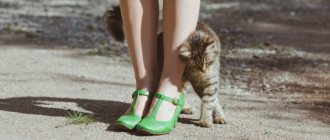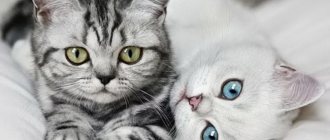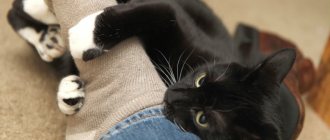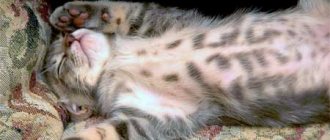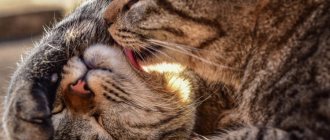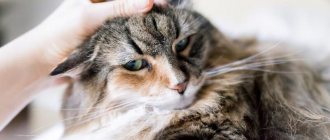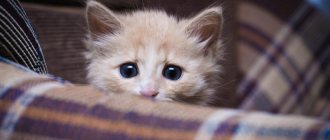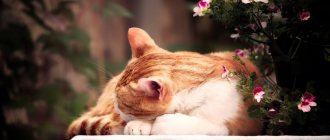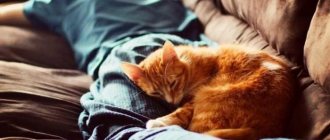Even many years of living with a pet cannot guarantee a complete understanding of its behavior. So many owners wonder why cats rub against their legs? This phenomenon often manifests itself in relationships between humans and animals. In addition, the pet may rub against other objects in the house and even outside it. Therefore, some owners need an explanation for this behavior of their pets.
The animal world differs significantly from the human world in terms of transmitting information. For these purposes, individuals often use odors. In particular, an excellent sense of smell gives cats the ability to quickly determine the position of the prey. This skill is one of the means of survival in the wild. Pets use their sense of smell to find a home or their own young.
© shutterstock
In an apartment, the pet still considers it necessary to limit the limits of its territory. This is the root cause of a cat rubbing against people or furniture, for example. There are special zones on the animal’s body that secrete a special secretion. Most of them are concentrated :
- on the muzzle;
- on the paws;
- around the anus.
It is especially noteworthy when a cat rubs its muzzle against its owner's face. After all, a huge amount of secretion is located in the forehead area. During such a ritual, the animal may purr and look extremely happy. This indicates that the process gives him satisfaction and brings peace. This reaction is associated with the original cause of this phenomenon: the cat feels safe in its territory.
By the way, this instinct is not only associated with creating boundaries. The fact is that cats live in families, and by smell they can determine whether they belong to a pride. Owners of two or more pets may notice that they are rubbing against the same object or corner. This is due to the fact that they belong to the same clan.
The importance of smells in the cat community
In the animal world, far from human understanding, having a sensitive sense of smell plays an important role for survival.
Much more effective than sight and hearing, the sense of smell helps to sense the approach of prey, a competitor or a sexual partner. With the help of smells, cats transmit information to each other about the belonging of an individual to a pride, items of personal property, as well as the boundaries of the territory. A secret with an individual smell for each individual helps to mark these boundaries.
The glands that produce a special substance are located in three places:
- Animal muzzle.
- Areas between the pads on the paws.
- Under the tail - at the anus.
Thus, when the cat begins to rub against parts of the owner’s body, he somehow leaves his scent. The same applies to its relatives, as well as various inanimate objects, including the corners of sofas and walls. This behavior means that the pet is marking its property, protecting it from attacks.
How to stop your pet from rubbing against your legs?
If owners of furry friends still want to wean their pets from such a harmless habit, they should follow the recommendations:
- When the cat approaches your feet, back away. Pet the animal. Do not Cry.
- If all family members are against cat pheromones on their clothes, stick to the same line of behavior. The cat will understand that no one likes her ritual and will most likely stop rubbing her legs.
Animals love selflessly
Man domesticated the cat thousands of years ago. He let her into his family. In a normal family, each member is respected and his or her characteristics are taken into account. Can such a harmless ritual for humans, but important for a pet, really cause unpleasant feelings? We should not offend those who love us selflessly.
Reasons for behavior
The cat ritual of wiping is somewhat similar to flirting. The pet presses its head against the owner's leg, then rubs its side, and as a finishing touch wraps its tail around the human limb. The animal performs the same manipulations with the hands of its owner, and sometimes pokes its muzzle in the face. This behavior has both an instinctive biological and social nature, which developed in the process of adaptation to home conditions.
To better understand cats, it is worth finding out why they continue to perform this ritual. Known reasons include:
- Marks. Just like personal belongings, toys, territory, for a cat a person is his personal property, a member of the family. When the owner is absent for a long time, his sign of belonging to the pride disappears. Purr senses this and begins to rub, correcting the misunderstanding.
- Collects information. This most often happens when guests come to the house. When coming into contact with someone new, the pet scouts the situation for a potential threat. In addition, by leaving its scent on guests, the animal adapts to their presence.
- Communicates with relatives. Domestic cats also have their own post office, and the postman is the owner of it. If a pet runs up to its human with a fit of tenderness, do not delude yourself. Perhaps the striped neighbor on the floor below conveyed very important news.
- Requires affection. In this case, a conditioned reflex is superimposed on the instinctive basis. It is produced by a kitten when it, marking a large and warm person with its scent, receives affection. As a result, the association is reinforced, and the animal begins to rub when it wants attention.
- He wants to eat. Here, rubbing is also associated with receiving pleasure after the ritual. However, it is not the only sign that the animal is asking to be fed. This is usually accompanied by meowing and a characteristic hungry look.
- Walking. During the period of sexual heat, females leave pheromones on their owners - messages for potential sexual partners. This is especially true for cats that do not go outside.
Interestingly, similar behavior can also occur among street animals. Often cats, on whose territory a person has set foot, thus declare their rights to him and show condescension.
What is a stray cat and how is it different from a domestic cat?
Stray cats are half-owned or unowned cats that roam the streets freely. These cats may have once lived under the care of humans but were abandoned or strayed for other reasons. Another situation where a cat becomes homeless is when it leaves the source of human care or its former owner may have passed away. He may also have lost contact or dependence on someone. A stray cat can also become a feral cat, but it can also become a pet and can be tamed.
Peculiarities of behavior of baleen-stripes
Among the reasons why pets often rub against human legs, there are two main ones:
- Label . In this way, the animal leaves its scent on them, or, more simply, it marks its territory. To find confirmation of this, it is enough to remember how purrs greet household members. First of all, they “initiate” their people into the smells of the house, where the cat feels, no more, no less, the mistress.
- Attract attention. Rubbing your legs is one of the ways to communicate and attract attention. It is believed that this helps the pet get something it wants. For example, cats show more effort and rub their legs more intensely if the owner has a treat in his hands. In such a situation, they begin to rub not only against the owner’s feet, but also against various pieces of furniture.
In order to understand why certain feline habits are associated, it is worth taking a closer look at the instincts and behavioral characteristics.
Both wild and domestic ones rub
One way or another, all cats, both big and small, periodically rub against someone or something.
This means that this behavior can be called species-wide:
- In nature, wild animals mark their habitat in this way. Felinologists claim that, regardless of size and habits, almost the entire body of cats has the scent of specific glands, especially in the muzzle area. So it doesn’t matter what part of the pet’s body rubs against its owner, it still leaves its smell.
- It can be noted that mother cats lick their babies and touch them with their muzzles. They mark them, as it were, endowing them with their scent, which is most intense in the area of the cheeks and neck.
- In their natural environment, these animals also leave scratch marks. This behavior is characteristic of all solitary individuals, except for lions living in a pride. For example, if in an area where tigers are found, marks are found on trees at a height of 2.5-3 m, then they could have been left by a large male standing on his hind legs and stretching out his front legs. This is a message to other tigers who find themselves in the territory already occupied by them. The higher the label, the larger, and therefore more dangerous, the competitor. And if a newcomer cannot leave scratches higher than the previous ones, then it is better for him to get out of other people's possessions.
Homemade cats. Pets can rub their muzzle or the front of their body against their owner's legs. Why do pets rub against their owner’s legs while being safe? There are also several reasons for this:
- perhaps the pet designates a zone in which he feels comfortable;
- it can be an expression of love and gratitude (read more about how cats express their feelings);
- a sign of anxiety - if the cat finds itself in a foreign, unusual territory or meets a stranger at home.
In the latter situation, the paraanal glands located in the area of the base of the tail are used.
Cats have a whole “arsenal” of glands, each of which is responsible for the production of a specific secretion. And animals use them based on their own needs.
Variety of scent marks
The secretory fluid secreted by the glands of animals consists of various odorous substances. Cats need some to find a sexual partner; with the help of others, they scare away enemies and defend themselves from their attacks. Thus, among the most “important” aromatic components used by cats are:
- Epagons - they are also called “love pheromones”. These substances contribute to the establishment of a love connection between individuals, although it turns out to be short-lived. Aromas of maternal care appear in the muzzle and neck area, and those that attract representatives of the opposite sex appear on the back of the body.
- Odmichnions are “path markers” that animals leave as they move. With their help, they find abandoned prey or housing. The glands located on the extremities are mainly responsible for the production of “guiding” odors.
- Toribones are considered indicators of fear and anxiety. Even if there is no visible danger, animals are able to warn of the approach of an enemy using certain odors. Most often, only representatives of the same species are able to “read” such a peculiar signal.
- Gonophions and gamophions are other products of external secretion that provide chemical communication between individuals of the same species. For example, they determine whether an individual has reached puberty.
- Lichneumonas are “tasty” pheromones, using which some individuals mark certain objects, for example, those with an attractive taste.
Why it is not recommended to drive away a cat that rubs against your legs
Cats have been domesticated since time immemorial, so it is not surprising that over several millennia a lot of superstitions and signs have appeared associated with these cute creatures:
- a cat sneezing at a wedding promises happiness to the newlyweds;
- The pet's tail will help get rid of barley; just apply it to the sore spot;
- if a pet shits on a patient’s clothes, then you should rejoice - it means the person is on the mend;
- When a cat sees off people getting ready to go on a journey with a loud meow, it is worth putting off the journey.
There is also an opinion that it is impossible to drive a pet away from you - a person who offends this animal is seriously sinning and in the next world he will be met by angry cats, biting and scratching.
Cats and religion. Felines acted as guides to another world in various religions, including Christianity. They were considered divine creatures and were greatly revered. In the early stages of the formation of the world's largest religion, cats were depicted next to saints. Francis of Assisi, one of the most famous Catholic saints, was once saved by a cat. He caught a rat infected with the plague. Since that time, services dedicated to these animals began to be held in churches.
Perhaps, by trying to rub against your legs, the pet is showing care and affection in this way, which means that refusal can offend and upset your furry friend. Cats have a good memory; they remember betrayal and neglect for a long time.
Also watch the video why cats rub against people:
Why you can't call cats by human names
Signs about cats for lonely people are no different from others. But it is noted that these are the ones who can give their pets human names in order to give the animal more humanity. But superstitions say that cats should have cat names, for example, Barsik, Fluffy and others.
Cats are not called by human names for various reasons. For example, for ethical reasons, it will be awkward if a person with the same name comes to visit. But another reason bears a religious imprint; moreover, in Christianity it is forbidden to call cats by names consonant with saints. This is considered desecration. Among other things, there is a theory that a cat with a human name lives shorter and is aggressive. But, in fact, this does not entirely coincide with reality, since there is a lot of evidence to the contrary - happy long-lived cats bear common names of people.
Medicinal animals
Many people believe in the healing properties of cats, and this theory has a lot of fans. It is not without reason that in Western countries, “animal therapy” and “pet therapy” - methods of treatment with animals - are often used for therapeutic purposes. Along with dogs, dolphins, horses, rodents, and birds, felines also successfully take part in this process:
- Communication with furry “healers” distracts from long-term therapy and improves the emotional state.
- Animals contribute to the socialization of people with mental disabilities.
- It has been proven that sessions during which a person is with a pet provide the same results as when taking nootropic drugs and antidepressants.
